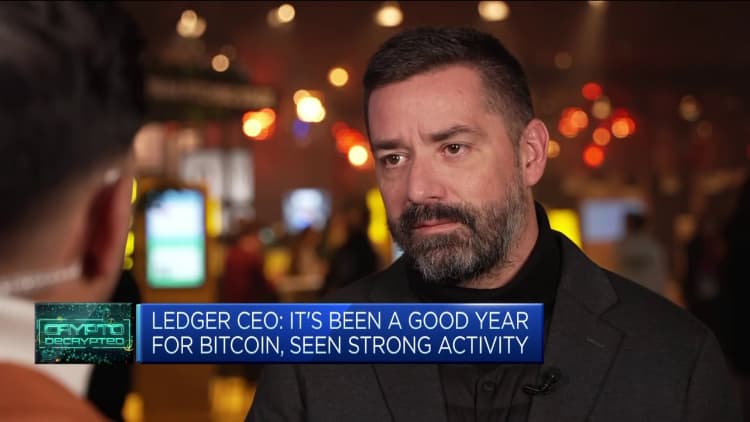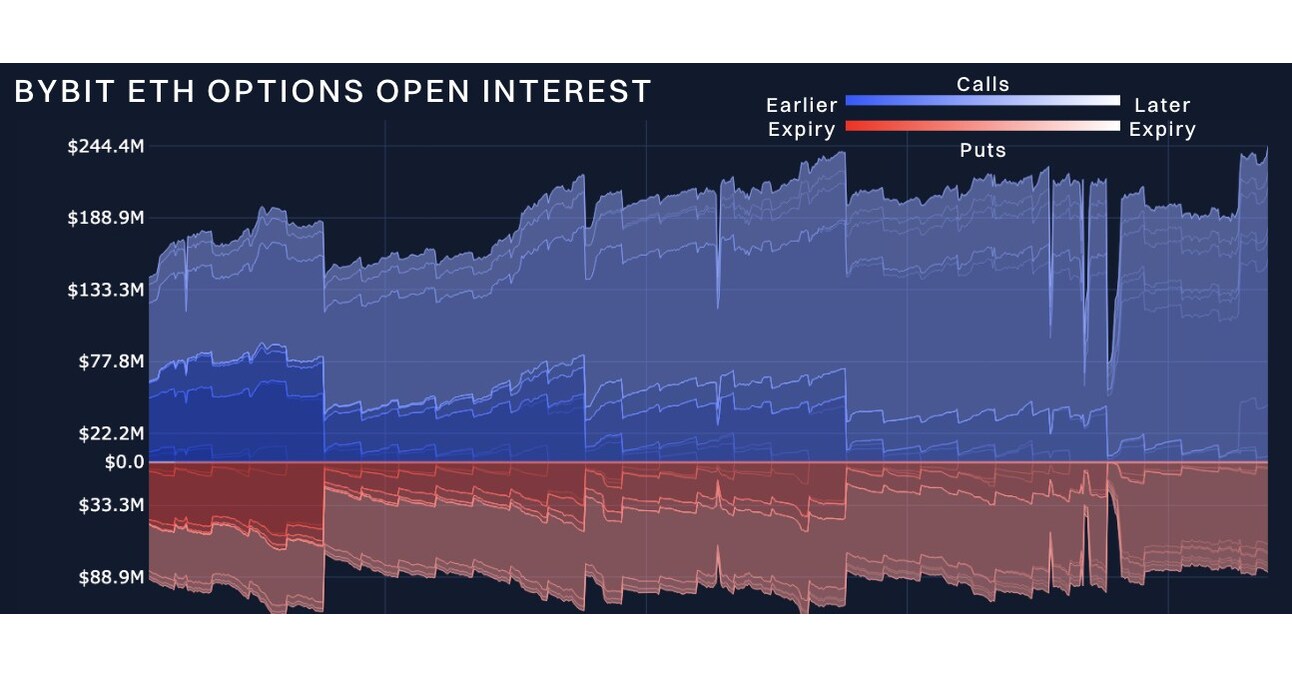Crypto
Crypto execs says the bull run is underway and could lead to $100,000 bitcoin in 2024

Yuichiro Chino | Moment | Getty Images
Executives in the cryptocurrency industry called the start of a new bull run with a growing number of voices calling for fresh all-time highs for bitcoin in 2024 above $100,000.
Bitcoin has rallied more than 120% this year, with many optimistic about the surge continuing into 2024.
“It feels that [2023]was a year to get ready for the bull run that is yet to come. But the sentiment is very hopeful for [2024] and 25,” Pascal Gauthier, CEO of Ledger, told CNBC last week in an interview.
The digital currency’s last record high of nearly $69,00 was hit in November 2021.
Since then, the crypto industry has been hit with a litany of issues from the collapse of coins and projects to bankruptcies and criminal trials. FTX, once one of the world’s biggest exchanges, collapsed with its founder Sam Bankman-Fried facing over 100 years in prison after he was found guilty on seven counts of criminal fraud.
Meanwhile, Binance chief Changpeng Zhao pleaded guilty to criminal charges and stepped down as the company’s CEO as part of a $4.3 billion settlement with the U.S. Department of Justice.
Many in the industry see the two cases concluding as a line being drawn under issues that have plagued the crypto market.
“I think that once you get the speculative phase out of the way, which I think we’re almost done with, probably not yet completely done, then you can get real builders focusing on the technology and the problems that can solve in the world, rather than just having a giant digital casino for people to trade,” David Marcus, CEO of Lightspark, told CNBC last week in an interview.
Marcus, the former leader of Facebook’s failed Diem stablecoin project, is now working on technology to improve bitcoin as a payments network.
Now that those issues are out the way, investors are focused on what the industry sees as positive developments. The first is the growing excitement that a bitcoin exchange-traded fund, or ETF, might be approved soon. This could bring in larger traditional investors who previously did not want to touch crypto.
“I think what the ETF means really is that bitcoin is going mainstream, and that’s what people were waiting for,” Gauthier said.
The second development is the bitcoin halving, which takes place every four years and is scheduled for May 2024. Halving is when miners, which are entities who uphold the bitcoin network, see the rewards for their work cut in half. This keeps a cap on the supply of bitcoin — of which there will ever only be 21 million coins — and often is a factor behind a new rally.
“A number of market participants are expecting a bull run some time after the halving, but given the ETF news, we could very well have a run before that leaving most investors on the sidelines. That could cause a massive upward run in the price,” Vijay Ayyar, vice president of international markets at cryptocurrency exchange CoinDCX, told CNBC.
Bitcoin at $100,000?
There have already been some bold calls for bitcoin in 2024.
It began with Standard Chartered last week which reiterated an April price call that bitcoin would hit $100,000 by end of 2024. The bank said this will be driven by the approvals of numerous ETFs.
That would mean a roughly 160% rally from Friday’s price of around $38,413, according to CoinDesk data.
Matrixport, which bills itself as a crypto financial services firm, released a note last week projecting bitcoin would reach $63,140 by April 2024 and $125,000 by the end of next year.
“Based on our inflation model, the macro environment is expected to remain a robust tailwind for crypto. Another decline in inflation is anticipated, prompting the Federal Reserve to likely initiate interest rate cuts,” Matrixport said in its report.
“Combined with geopolitical crosscurrents, this healthy dose of monetary support should push Bitcoin to new highs in 2024.”

Many commentators see easing monetary policy as supportive for bitcoin which is viewed as a risky asset. Meanwhile, some see bitcoin as a sort of “safe haven” asset to pour money into in times of geopolitical strife.
When asked if bitcoin would hit $100,000 in 2024, Gauthier said “maybe,” but declined to give a price prediction.
“What we see is strong fundamentals,” he said.
Ayyar said that the price of bitcoin is “consolidating” below a “key level” of $38,000, which is bullish for bitcoin. Once this level is broke, bitcoin could rally to between $45,000 and $48,000 next, he said.
However, he warned the rally, which is in large part built on expectations of an ETF approval, could fail if the product is rejected by regulators again.
“An all out ETF rejection could play havoc to this run as well, hence definitely something to be mindful of,” he said.

Crypto
Markets Show Resilience Ahead of End-of-Year Options Expirations: Bybit x Block Scholes Crypto Derivatives Report

DUBAI, UAE, Dec. 26, 2024 /PRNewswire/ — Bybit, the world’s second-largest cryptocurrency exchange by trading volume, released the latest Crypto Derivatives Analytics Report in collaboration with Block Scholes, highlighting the muted market volatility despite major options expirations on Friday. BTC and ETH’s realized volatility has increased, but short-term options haven’t adjusted to this change. This indicates that while spot prices are fluctuating, the options market is not fully reacting to these shifts, although BTC and ETH volumes have displayed slightly different patterns.
Sources: Bybit, Block Scholes
With more than $525 million in BTC and ETH options contracts expiring on Dec 27, 2024’s end-of-year options expiration looks set to be one of the biggest yet, yet expectations for volatility have remained subdued. The report highlights an unusual inversion in ETH’s volatility structure, but BTC has not mirrored the reaction. Additionally, a change in funding rates—sometimes turning negative as spot prices drop—signals a new market phase. Notably, BTC’s volatility structure has been less responsive to changes in spot prices, whereas ETH’s short-term options are exhibiting more noticeable fluctuations.
Key Findings:
BTC Options Expirations:
In the past month, BTC’s realized volatility has been higher than implied volatility on three occasions, each time reaching a relatively calm equilibrium. Open interest in BTC options remains high, contributing to potential increased volatility as we near the end of the year. Around $360 million worth of BTC options (both puts and calls) are set to expire soon, which can affect price movement.
ETH Options: Calls Dominate
Despite a mid-week inversion, ETH’s volatility term structure has flattened, maintaining levels similar to those seen over the past month. In the final week of 2024, calls overwhelmed puts in open interest in ETH options, although market movements and trading activities are more on the put side.
Access the Full Report:
Gain deeper insights and explore the potential impacts on your crypto trading strategies by downloading the full report here: Bybit X Block Scholes Crypto Derivatives Analytics Report (Dec 24, 2024)
#Bybit / #BybitResearch
About Bybit
Bybit is the world’s second-largest cryptocurrency exchange by trading volume, serving a global community of over 60 million users. Founded in 2018, Bybit is redefining openness in the decentralized world by creating a simpler, open and equal ecosystem for everyone. With a strong focus on Web3, Bybit partners strategically with leading blockchain protocols to provide robust infrastructure and drive on-chain innovation. Renowned for its secure custody, diverse marketplaces, intuitive user experience, and advanced blockchain tools, Bybit bridges the gap between TradFi and DeFi, empowering builders, creators, and enthusiasts to unlock the full potential of Web3. Discover the future of decentralized finance at Bybit.com.
For media inquiries, please contact: [email protected]
For more information, please visit: https://www.bybit.com
For updates, please follow: Bybit’s Communities and Social Media
Discord | Facebook | Instagram | LinkedIn | Reddit | Telegram | TikTok | X | Youtube
Photo – https://mma.prnewswire.com/media/2587821/Sources_Bybit_Block_Scholes.jpg
Logo – https://mma.prnewswire.com/media/2267288/Logo.jpg
Crypto
WSJ “Trump's Emphasis on Cryptocurrency and AI Highlights Need for Renewable Energy”

There is a prospect that the renewable energy industry could be revitalized due to President-elect Donald Trump’s proactive stance on cryptocurrency and artificial intelligence (AI).
On the 25th (local time), the Wall Street Journal (WSJ) highlighted the power consumption involved in AI and cryptocurrency mining businesses, predicting a need for more power sources. Senator Kevin Cramer told the Wall Street Journal, “We don’t have enough electricity for servers used in AI or cryptocurrency,” emphasizing the need for as much energy as possible, including not only fossil fuels but also renewable energy.
President-elect Trump has so far taken a negative stance on the ‘climate crisis’ and its solution, renewable energy, but it is explained that this position could change. The media noted, “Trump has previously criticized electric vehicles, but he shifted his stance after getting closer to Elon Musk, CEO of Tesla. Trump’s stance on renewable energy could also be relaxed.”
Crypto
1 Top Cryptocurrency to Buy Before It Soars 1,500%, According to Cathie Wood | The Motley Fool

Is Cathie Wood onto something huge with her latest crypto forecast? Find out why she expects unstoppable growth ahead.
It’s no secret that growth investing mastermind Cathie Wood expects big things from Bitcoin (BTC 0.05%). The Ark Invest fund manager started talking about crypto before she was a household name, and has recently doubled down on her bullish projections again.
In a Bloomberg TV interview last Thursday, Wood reiterated a Bitcoin price target of $1.0 to $1.5 million by the year 2030. But that’s not the whole story. The cool part of Cathie Wood’s Bitcoin coverage is that she keeps explaining her investment thesis in greater detail over time.
Last week’s interview was no exception. So let’s check out Cathie Wood’s latest nuggets of Bitcoin-friendly economic theory.
Why Cathie Wood sees Bitcoin as a bargain buy at $100,000
First, Wood noted that the probability of reaching her existing Bitcoin price targets has increased in 2024. Institutional investors are finally taking digital assets seriously, assisted by new tools like the spot Bitcoin exchange-traded funds (ETFs) that launched in January. Their Bitcoin investments should make a big difference to the asset’s price and stability over the next few years.
“[Large investors] must consider an allocation” these days, because there is a hard cap on Bitcoin production in the long run.
94.3% of all Bitcoin that will ever exist has already been produced and is sitting in crypto wallets around the world. You can’t grab a large slice of the total Bitcoin pie by making or finding more of it as one might do with physical assets such as gold or oil. The iron-fisted law of supply and demand should inevitably drive the price of this limited asset higher, so financial institutions should start building their Bitcoin portfolios before it gets expensive.
In this context, $100,000 per coin doesn’t qualify as “expensive.” Remember, the long-term target price is measured in millions of dollars. Cathie Wood is playing the long game here.
Bitcoin is a valuable accounting tool
Wood also explained that Bitcoin is more than a speculative asset. Rather than the next value-free “tulip bulb craze,” Bitcoin is serving a significant purpose for people who aren’t just expecting it to gain value over time.
“It’s a global monetary system that is rules-based,” she said. “It is private, it is digital, it is decentralized, and it is backed by the largest [computer system] in the world. It’s the most secure network in the world.”
Bitcoin is similar to a global and very detailed accounting system that tracks all the gold in the world, assigning an owner to every sliver of a gold nugget and protects the data with several layers of cryptography. You can’t cancel or change any transactions or ownership records without essentially breaking Bitcoin’s transaction-recording platform. The asset being tracked in this case is not a physical chunk of noble metal, but the computing work that went into generating a unique digital token.
There is an unknown but very real limit to the amount of physical gold in the world, until entrepreneurs find additional sources on asteroids or other planets. At the same time, there will simply never be more than 21 million Bitcoin tokens, and 19.6 of them are already in circulation. In the long run, this system is almost free from inflation — assuming its security holds up against new attack ideas such as quantum computing algorithms.
Cathie Wood is taking the mystery out of her investment thesis for Bitcoin. Image source: Getty Images.
Bitcoin vs. Gold: Different inflation effects
Cathie Wood also highlighted how this inflation-proofing approach differs from gold.
“When the gold price goes up, production goes up — the rate of increase in the supply goes up,” she said. “That cannot happen with Bitcoin. It is mathematically metered to go up 0.9% per year for the next four years, and then the supply growth will be cut in half again.”
Indeed, physical gold mining tends to become more common when the metal’s price is high. Miners want to take advantage of this valuable asset when it makes the most economic sense. The equation is different for Bitcoin miners, who will produce smaller and smaller chunks of the digital asset over time. So the cost of minting new Bitcoins will increase while the number of new coins introduced to the market slows down.
So it’s smarter to put in a maximum production effort as quickly as possible, because the return on your mining machinery and electric power investment will only shrink over the years. The same logic suggests that buying Bitcoin early will be more profitable in the long run. Waiting for a lower buy-in price or easier Bitcoin mining environment almost never makes sense.
Why Bitcoin may deserve a spot in your portfolio
So Cathie Wood underscored her 5-year Bitcoin target of at least $1 million per coin, and she offered more detail on her underlying investment thesis.
Other Bitcoin investors may work with different assumptions that result in various target prices, but the overall market tenor is pretty consistent. Bitcoin looks ready to rise from the recent $100,000 pricing milestone. From major banks to ordinary nest-egg builders, most investors should pay serious attention to these newfangled cryptographic tokens.
-
/cdn.vox-cdn.com/uploads/chorus_asset/file/24924653/236780_Google_AntiTrust_Trial_Custom_Art_CVirginia__0003_1.png)
/cdn.vox-cdn.com/uploads/chorus_asset/file/24924653/236780_Google_AntiTrust_Trial_Custom_Art_CVirginia__0003_1.png) Technology5 days ago
Technology5 days agoGoogle’s counteroffer to the government trying to break it up is unbundling Android apps
-

 News6 days ago
News6 days agoNovo Nordisk shares tumble as weight-loss drug trial data disappoints
-

 Politics6 days ago
Politics6 days agoIllegal immigrant sexually abused child in the U.S. after being removed from the country five times
-

 Entertainment1 week ago
Entertainment1 week ago'It's a little holiday gift': Inside the Weeknd's free Santa Monica show for his biggest fans
-

 Lifestyle7 days ago
Lifestyle7 days agoThink you can't dance? Get up and try these tips in our comic. We dare you!
-
/cdn.vox-cdn.com/uploads/chorus_asset/file/25672934/Metaphor_Key_Art_Horizontal.png)
/cdn.vox-cdn.com/uploads/chorus_asset/file/25672934/Metaphor_Key_Art_Horizontal.png) Technology2 days ago
Technology2 days agoThere’s a reason Metaphor: ReFantanzio’s battle music sounds as cool as it does
-

 Technology1 week ago
Technology1 week agoFox News AI Newsletter: OpenAI responds to Elon Musk's lawsuit
-

 News3 days ago
News3 days agoFrance’s new premier selects Eric Lombard as finance minister


















